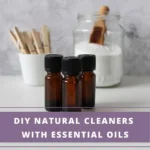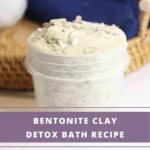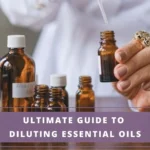As an Amazon Associate I earn from qualifying purchases. See Full Disclosure Here
It started off as a TikTok trend and took off overnight. Within a very short time, it seemed like everyone was talking about this DIY sea salt spray for acne and clear skin.
 At first, I dismissed it as, well, just another TikTok trend. But it soon became hard to ignore. All my friends’ teenage kids were talking about making and using this simple and ingenious solution for clearer skin. To cut a long story short – it works!
At first, I dismissed it as, well, just another TikTok trend. But it soon became hard to ignore. All my friends’ teenage kids were talking about making and using this simple and ingenious solution for clearer skin. To cut a long story short – it works!
Made using just three ingredients, this DIY sea salt spray for acne is a simple and easy way to get clearer, healthier skin. If you’re looking for a natural alternative to combat acne, this article’s for you.
In addition to the step-by-step procedure, I also explore the potential benefits of using sea salt spray to heal acne and how it can be incorporated into your skincare routine.
How Sea Salt Spray Works To Clear Acne
 I’ve experienced first-hand the positive effects of a dip in the ocean. Spending time in a natural body of salt water tightens your skin and leaves it feeling smoother and healthier. I never gave much thought as to why that happened until now.
I’ve experienced first-hand the positive effects of a dip in the ocean. Spending time in a natural body of salt water tightens your skin and leaves it feeling smoother and healthier. I never gave much thought as to why that happened until now.
The beneficial effects of this DIY salt water spray on acne are due to the minerals and nutrients present in seawater. Sea salt spray harnesses the properties of these naturally-sourced minerals, serving as an all-over skin nourishing spray.
Here are some of the benefits of spritzing this homemade sea salt spray on your skin.
Acts As A Gentle Exfoliant
Because of its granular nature, sea salt acts as an effective exfoliant.
When applied topically, it gently exfoliates the skin, removing dead cells and unclogging pores. This can prevent the buildup of bacteria and excess oil, which are common causes of acne.
By eliminating these acne-causing impurities, this DIY sea salt spray reduces acne breakouts and promotes clearer skin.
Has Antibacterial & Antimicrobial Properties
Sea salt is rich in natural minerals such as magnesium and potassium that have antibacterial and antimicrobial properties.
When applied to acne-prone skin, this saltwater spray inhibits the growth of bacteria that cause acne. The antibacterial properties of sea salt together with its exfoliating abilities make it an effective tool for calming inflammation and preventing new acne lesions.
The antimicrobial properties of sea salt also help dry out pimples and combat acne-causing bacteria.
Has Anti-Inflammatory Properties
In addition to antibacterial properties, the minerals in sea salt also possess anti-inflammatory properties. These properties can help reduce redness, inflammation, and irritation, all of which are associated with acne breakouts.
Regulates Oil Production
Sea salt can help balance the production of sebum, the skin’s natural oil. By regulating oil levels, sea salt can prevent the skin from becoming too oily or dry, thus reducing the likelihood of acne flare-ups.
Is Rich In Magnesium
Sea salt contains magnesium, which is known for its calming and healing effects on the body. Some individuals with skin conditions like eczema and psoriasis have also found relief from symptoms by exposing their skin to salty ocean water.
While scientific studies specifically on sea salt spray for acne are limited, anecdotal evidence suggests that it can be effective in reducing acne and promoting skin healing.
Making your own sea salt spray for acne is a simple and cost-effective way to incorporate this natural remedy into your skincare routine.
DIY Sea Salt Spray For Acne: Ingredients
• 1 tablespoon Dead Sea salt or Himalayan Pink Salt
• 1 cup Distilled Water or Filtered water
• 2-3 drops of Tea Tree essential oil (optional, for its antibacterial properties)
• 1-2 drops of lavender essential oil (optional, for a soothing effect)
• A spray bottle
Instructions:
1. Wash your spray bottle thoroughly with warm soapy water and rinse it well. You want to make sure it is free of any dust or debris.
2. Warm the warm water just a little and pour it into the spray bottle.
3. Add 1 tablespoon sea salt to the water.
4. Optional – Add 4-6 drops of tea tree oil and 1 teaspoon carrier oil to the salt water.
5. Close the spray bottle and shake well to ensure the salt is dissolved.
6. Your homemade sea salt spray is now ready to use!
Note About The Ingredients + Substitutions
Sea Salt
Unrefined sea salt that hasn’t undergone extensive processing is the most effective for this acne recipe. This is because unrefined salt retains its natural mineral content, which provides anti-acne benefits for the skin.
Table salt, on the other hand, undergoes extensive processing that strips it of all its inherent minerals and beneficial properties. Using table salt in this salt water spray for acne will do nothing to clear your skin.
There are a couple of different types of sea salt that you can use. Each of these has a slightly different composition depending on where they are sourced from. The grain size doesn’t matter as you will be dissolving the salt in water.
Dead Sea Salt: Rich in minerals such as potassium, magnesium, and calcium, Dead Sea Salt has always been hugely popular among skincare enthusiasts. It gets its name from its source, the Dead Sea, which is so saturated with salts that you can actually float on the water. Dead Sea Salt is my top recommendation for use in this DIY sea salt spray for acne.
Himalayan Pink Salt: Another mineral-rich salt, Himalayan Pink Salt is easily recognizable by its distinctive orange-pink coloration. Harvested from the foothills of the Himalayas, this salt contains iron, selenium, and zinc. These three minerals have known benefits for the skin.
Celtic Sea Salt – Grey or off-white in color, Celtic Sea Salt is obtained from the coastal regions of France through traditional hand-harvesting methods. This salt contains high levels of essential electrolytes including magnesium, sodium, and potassium. These electrolytes are crucial for maintaining hydration, nerve and muscle function, and pH balance.
Essential Oils
Tea tree is the best essential oil for acne. With its potent antibacterial and anti-inflammatory properties, tea tree essential oil effectively targets and kills acne-causing bacteria, reducing the risk of new breakouts.
Additionally, its anti-inflammatory action helps soothe existing acne lesions, promoting faster healing and a clearer complexion.
Both of these benefits make tea tree oil a hugely beneficial addition to this recipe. It is not absolutely necessary though.
if you do add tea tree, you must also add the carrier oil to prevent the essential oil from direct contact with the skin.
Distilled Or Filtered Water
While you can use tap water in a pinch, I would advise against it for regular use. Tap water contains chlorine and may also contain other impurities. Both of these are detrimental to your skin.
Distilled or filtered water is free of chlorine and other impurities and is gentler on your skin. This is especially important as you’ll be applying the spray to acne-prone skin, which is generally very sensitive.
How to Use Homemade Sea Salt Spray for Acne
 Using sea salt spray for acne is a straightforward process:
Using sea salt spray for acne is a straightforward process:
Cleanse your face thoroughly with a gentle cleanser to remove any dirt or makeup.
Shake the bottle gently to distribute the ingredients evenly in the bottle.
Close your eyes and hold the spray bottle approximately 6-8 inches away from your face.
Spritz the sea salt spray onto your face, focusing on areas affected by acne or inflammation.
Using your fingertips, clean cotton wool, or a makeup remover pad, gently pat the spray into your skin.
Let the salt water spray air dry on your skin.
Leave it on for as long as you’re comfortable and it’s not bothering you. This will allow you skin to get the benefits of the minerals for longer.
You don’t have to rinse off the sea salt spray from your skin unless leaving it on feels uncomfortable.
Follow up with your regular moisturizer to prevent excessive dryness.
This DIY sea salt spray for acne can be used on any part of the body, not just the face. Follow the same instructions as above.
Frequency of Use
Start by using the sea salt spray once a day. If your skin tolerates it well, gradually increase the frequency to twice a day – once in the morning and once at night.
Consistency is key, so make sure to incorporate this DIY sea salt water spray into your daily skincare routine. Remember, everyone’s skin is unique, so it may take time to see noticeable improvements. Be patient and give the sea
How Long Does It Take To See Results?
It depends. I’m sorry, I know it’s the last thing you want to hear but it’s the truth.
Everybody’s skin is different and will react differently to this homemade sea salt spray for acne. Its effectiveness will depend on your skin type as well as the severity of your acne.
You should see a difference within a couple of weeks if you have mild acne. If your acne more severe acne, it could take much longer to see results. I would also strongly recommend consulting a dermatologist if you have severe acne.
Consistency truly is key to seeing any improvement.
How To Store Your Homemade Sea Salt Spray
Although none of the ingredients tend to spoil, it’s best to exercise caution.
My first tip would be to make a smaller quantity that you can use without a reasonable time frame. Store the salt water spray in an airtight bottle to prevent excessive exposure to air, which can promote the growth of bacteria.
For best results, store the bottle in the refrigerator.
Inspect the bottle and the contents regularly to ensure it is unspoiled. It you notice any changes in smell, color, or consistency, discard the contents. Clean out the bottle thoroughly as before and prepare a fresh batch.
Usage Tips, Considerations, & Precautions
While sea salt can be beneficial for many people, it may not be suitable for everyone. If you have highly sensitive or irritated skin, it’s best to consult with a dermatologist before using a sea salt spray.
Perform a patch test before applying the sea salt spray to your face. To do this, spritz a small amount to the inside of your forearm. Wait for a few hours. If your skin reacts to the contents, it’s best to avoid spraying it on your face where the skin is even more delicate.
Avoid using sea salt spray on open wounds, cuts, or broken skin.
Avoid overuse, as it can potentially irritate the skin.
Stick to the recommended usage of once a day at the beginning and progress to twice a day after a week or so.
Do not scrub your face with larger salt crystals, as this can cause irritation and damage to the skin.
If you are already using other exfoliating ingredients or treatments, it is best to avoid using sea salt spray simultaneously to prevent excessive exfoliation.
If you have sensitive or dry skin, it is advisable to consult with a dermatologist before incorporating sea salt spray into your routine.
Every person’s skin is unique, and what works for one may not work for another. If you experience any adverse reactions or discomfort, discontinue use and consult a dermatologist.
Embracing a Natural Approach to Acne Treatment
Creating your own DIY sea salt spray for acne is a simple and cost-effective way to incorporate natural ingredients into your skincare routine. The exfoliating and anti-inflammatory properties of sea salt, combined with the antibacterial effects of tea tree oil, can help reduce acne breakouts and promote clearer, healthier skin.
Remember to listen to your skin and make adjustments to the frequency of use if necessary.
With regular use and proper skincare habits, you will start to see improvements in your complexion. Using aloe vera gel for face can help too.
FAQs
How often should I use the sea salt spray?
The ideal frequency of use depends on your skin’s tolerance.
Start by using the sea salt spray once a day and monitor how your skin reacts. If it doesn’t cause excessive dryness or irritation, you can gradually increase the frequency to twice a day.
Can I use this sea salt spray with other acne treatments?
Yes, you can but you must exercise caution – speak to your dermatologist, start slow, perform a patch test, and monitor your skin’s reactions to the salt water. Only proceed if your skin tolerates the spray well.
Can I use the sea salt spray if I have sensitive skin?
It’s best to proceed with caution if you have sensitive skin. While sea salt can be beneficial for many, it may cause dryness or irritation in some individuals.
Conduct a patch test on a small area of skin before applying the spray to your entire face. If you experience any adverse reactions, such as redness or increased sensitivity, discontinue use and consult with a dermatologist.
Have you tried this DIY sea salt spray for acne and did it work for you? Let me know in the comments below.
Disclaimer: This article is for informational purposes only and should not be considered medical advice. Please consult with a dermatologist or healthcare professional before trying any new skincare products or treatments. See Full Disclaimer here.









